
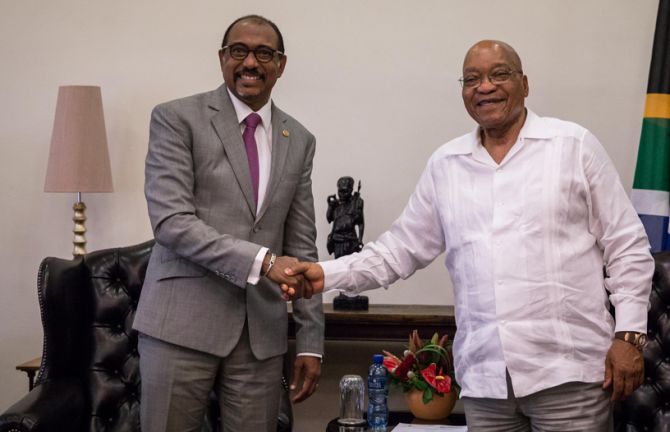
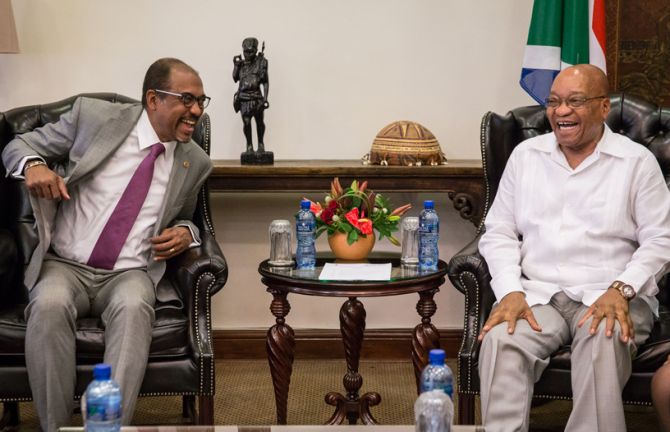
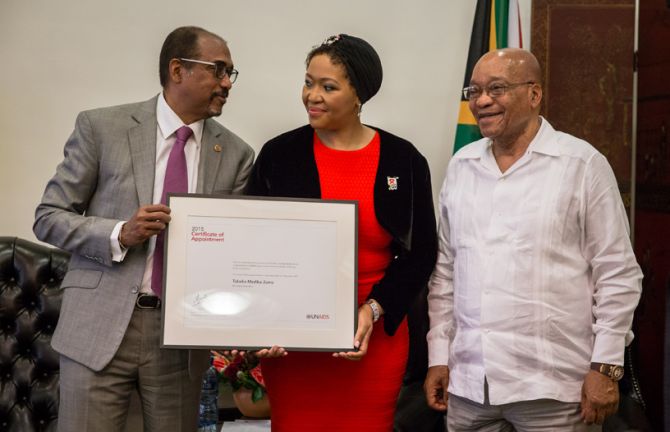
Press Release
The Executive Director of UNAIDS commends the President of South Africa for his bold leadership on HIV
02 December 2015 02 December 2015The government’s commitment to ending the AIDS epidemic in South Africa has saved millions of lives
PRETORIA/GENEVA, 2 December 2015—The Executive Director of UNAIDS, Michel Sidibé, has commended the President of South Africa, Jacob Zuma, for his bold and visionary leadership in responding to HIV. During a meeting in Pretoria, Mr Sidibé and President Zuma discussed the country’s plans to end the AIDS epidemic in South Africa and how UNAIDS can support South Africa to advance its Fast-Track efforts to reach ambitious targets by 2020 and drive the epidemic into permanent decline.
“I appreciate the support that UNAIDS has given South Africa since Mr Sidibé first visited for World AIDS Day in 2009,” said President Zuma. “I remember we were together then, and he also came the following year, when we both tested for HIV in public. People said I was crazy, but I knew it had to be done to show people that they didn’t have to be afraid. He was with us then and he will be with us every step of the way to ending AIDS.”
During Mr Sidibé’s 2009 visit, President Zuma, who was newly elected as President earlier that year, made major policy announcements that sparked a new era in South Africa’s response to HIV.
“South Africa has completely changed the face of the epidemic,” said Mr Sidibé. “These changes are a result of President Zuma’s bold leadership, taking South Africa out of a dark period of despair, dependency and denial to a time of hope, ownership and full responsibility.”
South Africa now has the largest HIV treatment programme in the world, with more than 3 million people accessing treatment across the country. South Africa currently tests 10 million people annually for HIV and around 600 000 people newly started antiretroviral therapy in 2014 alone. These programmes have been supported by an unprecedented domestic investment in HIV―currently $1.8 billion a year― and the second largest in the world.
In 2014 President Zuma, Former President Bill Clinton, UNAIDS and other partners brokered a radical reduction in the cost of viral load testing, thereby making it possible for many more people to be tested and the effectiveness of their treatment to be monitored.
One of the biggest successes in South Africa’s response has been in stopping new HIV infections among children. In 2004, approximately 70 000 babies became newly infected with HIV; by 2014, that number had been reduced by almost 90%.
Press centre
Download the printable version (PDF)
Region/country

Press Release
On World AIDS Day 2015, Executive Director of UNAIDS calls on countries to quicken the pace of action
01 December 2015 01 December 2015Fast-Track Strategy to reach people with HIV prevention and treatment and end the AIDS epidemic as a public health threat
DURBAN/GENEVA, 1 December 2015—On World AIDS Day 2015, the Executive Director of UNAIDS, Michel Sidibé, has said that countries are on a countdown to ending their AIDS epidemics and that if swift and effective action is taken over the next five years, one by one they will break their epidemics so that they cannot rebound.
Mr Sidibé made the remarks as he joined the Deputy President of South Africa, Cyril Ramaphosa, at South Africa’s national World AIDS Day event, which was held in the Ugu District of KwaZulu-Natal Province on 1 December.
Introduced by Aaron Motsoaledi, the Minister of Health of South Africa, Mr Ramaphosa reflected on what World AIDS Day means to him: celebrating the courage of people living with HIV, evaluating the progress―or lack thereof―of the national AIDS response, recognizing partners and recommitting to the goal an HIV-free generation.
“This is the time for all of us to rise, act and protect. As a nation we must rise to the challenge and be confident that we can succeed,” said Mr Ramaphosa. “Yes, we will be triumphant and yes, we will make progress. As a nation and as individuals we must act to support and encourage others, and we must protect ourselves and those near to us.”
In his remarks, Mr Ramaphosa thanked Mr Sidibé for his role in encouraging South Africa to lead the charge towards ending AIDS.
“South Africa’s story is one of moving from denial to acceptance, from dependency to ownership and from despair to hope, with impressive results,” said Mr Sidibé. “South Africa has shown us not to be afraid of our future, but to shape it.”
Political leadership, community engagement and global solidarity have changed the face of the epidemic in South Africa.
In 2009, only a few hundred thousand people had access to antiretroviral therapy in South Africa. In just six years the number more than tripled, and in 2014 more than 3 million South Africans were accessing the life-changing treatment.
This was made possible by the government’s commitment and investment in the national response to HIV. South Africa invests US$ 1.8 billion dollars in the AIDS response—the second largest domestic investment in the world and the biggest in Africa. South Africa also secured a 53% reduction in the price of the provision of antiretroviral medicines. This has allowed more people to have access to treatment and has saved the country almost US$ 685 million over a two-year period.
The World AIDS Day event included participation by community champions, people living with HIV and a range of civil society organizations. A candle lighting ceremony was held to remember and honour loved ones lost to the AIDS epidemic.
“The world is facing a fragile five-year window of opportunity to break the epidemic and keep it from rebounding,” said Mr Sidibé. “We will not win against AIDS without communities. They are essential partners for the future success of the AIDS response.”
By supporting community organizations and strengthening local services, countries will be able to reach people who are still being left behind in the response to HIV. Ensuring access to HIV services for key populations will lead to healthier and more resilient societies. It will also significantly advance efforts to prevent new HIV infections and AIDS-related deaths, and to eliminate HIV-related stigma and discrimination.
UNAIDS estimates that a record 15.8 million people are now accessing treatment globally. However, 21.1 million people still do not have access to treatment and 17 million people do not know they are living with HIV. With attention to location and population, countries will be able to redistribute resources to improve access to HIV prevention, testing and treatment services and close the gaps towards ending the AIDS epidemic by 2030.
|
15.8 million people were accessing antiretroviral therapy (June 2015) 36.9 million [34.3 million–41.4 million] people globally were living with HIV (end 2014) 2 million [1.9 million–2.2 million] people became newly infected with HIV (end 2014) 1.2 million [980 000–1.6 million] people died from AIDS-related illnesses (end 2014) |
UNAIDS
The Joint United Nations Programme on HIV/AIDS (UNAIDS) leads and inspires the world to achieve its shared vision of zero new HIV infections, zero discrimination and zero AIDS-related deaths. UNAIDS unites the efforts of 11 UN organizations—UNHCR, UNICEF, WFP, UNDP, UNFPA, UNODC, UN Women, ILO, UNESCO, WHO and the World Bank—and works closely with global and national partners towards ending the AIDS epidemic by 2030 as part of the Sustainable Development Goals. Learn more at unaids.org and connect with us on Facebook, Twitter, Instagram and YouTube.

Press Release
UNAIDS urges countries across Africa to Fast-Track their response to HIV
30 November 2015 30 November 2015GENEVA/HARARE, 29 November 2015—At the opening of the 18th International Conference on AIDS and STIs in Africa (ICASA), taking place from 29 November to 4 December in Harare, Zimbabwe, UNAIDS has urged countries to further accelerate their response to HIV. The biennial conference is taking place at a defining moment in the response to the epidemic.
“Africa is on the brink of breaking the AIDS epidemic,” said UNAIDS Executive Director Michel Sidibé at the opening ceremony of the conference. “We have no time to lose. We have five years to Fast-Track the AIDS response so that the epidemic can’t rebound.”
UNAIDS is hosting several special sessions at ICASA, including one to discuss its new Fast-Track Strategy. Fast-Track involves front-loading investments in the AIDS response to reach an ambitious 90—90—90 treatment target by 2020. Reaching this target would see 90% of people living with HIV knowing their HIV status, 90% of people who know their HIV-positive status accessing treatment and 90% of people on treatment having suppressed viral loads. Reaching the Fast-Track Targets will also reduce new HIV infections by 75% and realize the vision of zero discrimination. The Fast-Track Strategy will see resources concentrated in locations with the greatest need and among populations at higher risk of HIV.
Other sessions organized by UNAIDS at ICASA include sessions on AIDS in emergency, conflict and humanitarian contexts and on optimizing the prevention of mother-to-child transmission of HIV through community engagement and mobilization.
The conference is taking place against a backdrop of great progress in the response to HIV, even though many challenges remain. Worldwide, 15.8 million people now have access to life-saving antiretroviral medicines, with more than 10 million people in sub-Saharan Africa accessing treatment. Based on the increased weight of scientific evidence concerning earlier treatment, the World Health Organization has released new guidance recommending that people be offered access to antiretroviral medicines as soon as possible after their HIV diagnosis regardless of their CD4 count.
In sub-Saharan Africa, the number of AIDS-related deaths in 2014 was 48% lower than in 2005, while new infections have declined by 41% since 2000. Scaled-up access to antiretroviral medicines in 21 high-priority countries has resulted in a fall of 48% between 2009 and 2014 in the number of children becoming infected with HIV. A number of countries including Ethiopia, Mozambique, Namibia, South Africa, Swaziland, Uganda and the United Republic of Tanzania have experienced declines of more than 60% in the number of children becoming infected with HIV.
However, major challenges still remain across the continent. The same progress is not being seen among young women and adolescent girls, for example, with young women aged 15-19 years old accounting for 71% of new HIV infections among this age group in sub-Saharan Africa.
In 2014, there were 36.9 million people living with HIV globally, 25.8 million of whom lived in sub-Saharan Africa.
UNAIDS
The Joint United Nations Programme on HIV/AIDS (UNAIDS) leads and inspires the world to achieve its shared vision of zero new HIV infections, zero discrimination and zero AIDS-related deaths. UNAIDS unites the efforts of 11 UN organizations—UNHCR, UNICEF, WFP, UNDP, UNFPA, UNODC, UN Women, ILO, UNESCO, WHO and the World Bank—and works closely with global and national partners towards ending the AIDS epidemic by 2030 as part of the Sustainable Development Goals. Learn more at unaids.org and connect with us on Facebook, Twitter, Instagram and YouTube.

Press Release
Nominations now open for the Red Ribbon Award to honour and promote community leadership and action on AIDS
30 November 2015 30 November 2015Red Ribbon Award—honouring the best in community support to people living with and affected by HIV
1 December 2015—On this year’s World AIDS Day, UNAIDS and civil society partners, in collaboration with the organizers of the 21st International AIDS Conference, jointly announce a global call for nominations for the 2016 Red Ribbon Award. The award, which will be presented at the 21st International AIDS Conference, to be held in July 2016 in Durban, South Africa, honours community-based organizations for their contributions to the response to AIDS.
Community-based organizations have been instrumental in achieving the progress made so far towards ending the AIDS epidemic, which has seen new HIV infections fall by 35% since 2000 and AIDS-related deaths fall by 42% since the 2004 peak. Moreover, 15.8 million people living with HIV now have access to antiretroviral treatment.
Winning a Red Ribbon Award is highly respected by community-based organizations around the world. In 2014, more than 1000 nominations were received. The award not only brings a deserved spotlight on the most inspiring and innovative community responses, it also highlights the crucial importance of the community response to HIV and helps communities advocate for their involvement in the AIDS response with local, national and global leaders and decision-makers.
The biennial award is given to 10 organizations that have shown outstanding community leadership and action on HIV. The five award categories are:
- Good health and well-being (Sustainable Development Goal 3).
- Reduced inequalities (Sustainable Development Goal 10).
- Gender equality (Sustainable Development Goal 5).
- Just, peaceful and inclusive societies (Sustainable Development Goal 16).
- Global partnerships (Sustainable Development Goal 17).
These categories highlight the key elements of the UNAIDS Fast-Track Strategy targets to be met by 2020 to end the AIDS epidemic as a public health threat by 2030. Community-based organizations active in these categories have an important role to play in achieving the UNAIDS 90–90–90 treatment target by 2020 of 90% of people living with HIV knowing their status, 90% of people who know their HIV-positive are on treatment and 90% of people on treatment have suppressed viral loads.
Each winner of the award will receive US$ 10 000. Representatives of each winning body will present the work of their organization, their priorities, the challenges they face and their approaches to community engagement at the 21st International AIDS Conference.
Nominations will be accepted from 1 December 2015 to 14 February 2016. Nominations can be submitted online at www.redribbonaward.org, where further information can be found. Community-based organizations* working to halt and reverse the spread of HIV are encouraged to apply.
* Please note that only community-based organizations with an annual operating budget below US$ 200 000 should be nominated, and that organizations should have been established for more than one year at the time of nomination.
For more information, please visit www.redribbonaward.org.
UNAIDS
The Joint United Nations Programme on HIV/AIDS (UNAIDS) leads and inspires the world to achieve its shared vision of zero new HIV infections, zero discrimination and zero AIDS-related deaths. UNAIDS unites the efforts of 11 UN organizations—UNHCR, UNICEF, WFP, UNDP, UNFPA, UNODC, UN Women, ILO, UNESCO, WHO and the World Bank—and works closely with global and national partners towards ending the AIDS epidemic by 2030 as part of the Sustainable Development Goals. Learn more at unaids.org and connect with us on Facebook, Twitter, Instagram and YouTube.
The Red Ribbon Award Partners
Press centre
Download the printable version (PDF)

Press Release
Three new agreements announced with the potential to expand access to innovative HIV treatment in low- and middle-income countries
30 November 2015 30 November 2015HARARE/GENEVA, 30 November 2015—The Clinton Health Access Initiative, Inc. (CHAI), UNAIDS, and UNITAID announce today three new agreements that could increase access to more sustainable HIV drug regimens at reduced prices, pending stringent regulatory approval and/or World Health Organization (WHO) pre-qualification.
These agreements have the potential to increase access to state-of-the-art HIV treatment regimens for people living with HIV in low- and middle- income countries. The regimens are expected to be more durable and produce fewer side effects than existing drugs and are included in the revised 2015 WHO consolidated guidelines on the use of antiretroviral drugs for treating and preventing HIV infection.
“Ensuring access to the most innovative and effective medicines for all people with HIV is essential in every country,” said Dr Margaret Chan, WHO Director-General. “I applaud CHAI and all the partners involved for these agreements, which move us one step closer to a world without AIDS.”
Under the first agreement, Aurobindo Pharma Limited has agreed to make generic dolutegravir (DTG) available for US$44 per patient per year, subject to regulatory approval. At this price, a DTG-containing regimen is comparable in price to the leading first-line regimen containing efavirenz (EFV). WHO now recommends DTG as an alternate first-line therapy in those intolerant of efavirenz. There are, as yet, insufficient data to recommend the use of DTG in women who are or wish to become pregnant or for people on treatment for tuberculosis; associated studies are currently underway.
The launch price agreement for DTG was made possible in part by the leadership of the Government of Kenya, which agreed to incorporate DTG into national treatment guidelines and begin providing DTG to suitable patients as soon as regulatory approval is received.
ViiV Healthcare licensed Aurobindo for generic DTG, enabling Aurobindo to file for tentative approval with the U.S. Food and Drug Administration (US FDA) for the single formulation in May 2015, making this the fastest filing for a generic antiretroviral following approval for the originator, which occurred in August 2013. As a part of today’s agreement, Aurobindo confirmed they will also file for a one-pill, once per day fixed-dose combination of DTG (combined with tenofovir disoproxyl fumarate and lamivudine) with the US FDA by Q3 2016. ViiV has also enabled other manufacturers to develop this fixed-dose combination through an earlier license provided to the Medicines Patent Pool.
"Bringing effective new HIV drugs to the millions of people who have still not initiated treatment is a big challenge in global health today," said UNITAID Executive Director Lelio Marmora. "The agreements announced between CHAI, UNAIDS and UNITAID with four manufacturing partners will be crucial to having game-changing medications included in WHO and national guidelines and brought to market more speedily."
Secondly, Mylan Laboratories Limited will file for US FDA tentative approval for an alternate first-line fixed-dose combination regimen in Q1 2016, and make it available for US$99 per patient per year, subject to regulatory approval. The new product, TLE400, contains tenofovir disoproxyl fumarate, lamivudine, and a reduced dose of efavirenz, and produced positive results in the ENCORE1 clinical study by the Kirby Institute at the University of New South Wales, Australia. Again, there are insufficient data to recommend this combination in TB patients or women who are pregnant, but related studies are either planned or underway. The new price marks an 8% decrease from current prices and could generate US$80-100 million in savings globally through 2020, if approved. To foster future competition and ensure supply security, the Kirby Institute and CHAI have agreed to make the study data available to companies seeking to develop other generic versions of TLE400.
“Ensuring access to high quality and affordable HIV drugs for all people living with the virus is a top priority for Zimbabwe,” said Honorable Dr. David Parirenyatwa, Minister of Health and Child Care in Zimbabwe. “We look forward to adopting TLE400 as our standard first-line treatment as soon as ongoing efficacy trials amongst pregnant women and TB patients are complete and it receives the appropriate regulatory approvals and is available. The clinical benefits and affordability make it the right choice for Zimbabwe, and we thank CHAI, UNAIDS, UNITAID and Mylan for helping to make this possible.”
Thirdly, a new partnership between Janssen: Pharmaceutical Companies of Johnson & Johnson and CHAI will facilitate the development and delivery of a heat-stable formulation of darunavir/ritonavir (DRV/r) to enhance its availability in resource-limited settings. For the first time, the revised 2015 WHO HIV treatment guidelines include DRV/r as an alternative component of second- or third-line HIV treatment regimens for adolescents and adults. DRV/r has a favorable resistance and tolerability profile compared to the current treatment options (lopinavir/ritonavir and atazanavir/ritonavir) and represents a once-daily regimen option for patients on second-line treatment. CHAI is also partnering with Hetero Drugs Limited to accelerate development of a generic version of DRV/r, and Hetero has committed to file for regulatory approval by Q3 2016. Together, these partnerships will aim to address development, manufacturing, and uptake barriers in order to expedite DRV/r availability in resource-limited settings. Janssen is the originator manufacturer for DRV; please see accompanying full Product Information for more details.
“As a global community, we need to ensure that the 15.8 million people currently on HIV treatment, and the millions more to be initiated on treatment over the next few years, have access to the best possible drugs to treat the disease and prevent further spread of the disease,” said Ira Magaziner, CEO of CHAI. “The agreements announced today are a great step forward in that effort, and CHAI is pleased that our continued collaboration with UNAIDS, UNITAID, WHO, the British Government, and industry partners has enabled this success.”
Together, these agreements have the potential to enhance access to optimal HIV treatment regimens and improve treatment outcomes for people in low-and middle-income countries. Increased access to treatment, retention in care, and improved treatment outcomes are critical to reaching the ambitious global 90-90-90 treatment targets, which aim to lay the foundation to end AIDS as a public health threat by 2030. The 90-90-90 targets require that by 2020, 90 percent of all people living with HIV will know their HIV status; 90 percent of all people with an HIV diagnosis will receive sustained antiretroviral therapy; and 90 percent of all people receiving antiretroviral therapy will achieve viral suppression.
“Access to life-changing HIV treatment should not be a lottery based on where you happen to live. To ensure equity and sustainability in the global AIDS response, continued collaboration with our industry and technical partners is essential to make optimal first-, second- and third-line HIV treatment regimens available and affordable for all people living with HIV,” said Michel Sidibé, UNAIDS Executive Director. “We welcome today’s agreements which we hope will improve treatment options available to all countries and help us to achieve our ambitious 90-90-90 treatment targets.”
CHAI and UNITAID are committed to an open, competitive marketplace for the products included in these agreements, and the suppliers included here are those that are closest to having product dossiers ready for stringent regulatory approval and/or WHO pre-qualification; any suppliers who are committed to developing these products to the same standards will also receive support.
CHAI’s contribution was made possible through the generous support of UNITAID and the UK Department for International Development.
Clinton Health Access Initiative, Inc.
The Clinton Health Access Initiative, Inc. (CHAI) is a global health organization committed to strengthening integrated health systems and expanding access to care and treatment in the developing world. CHAI’s solution-oriented approach focuses on improving market dynamics for medicines and diagnostics; lowering prices for treatment; accelerating access to life-saving technologies; and helping governments build the capacity required for high-quality care and treatment programs. For more information, please visit clintonhealthaccess.org and connect with us on Facebook and Twitter.
UNAIDS
The Joint United Nations Programme on HIV/AIDS (UNAIDS) leads and inspires the world to achieve its shared vision of zero new HIV infections, zero discrimination and zero AIDS-related deaths. UNAIDS unites the efforts of 11 UN organizations—UNHCR, UNICEF, WFP, UNDP, UNFPA, UNODC, UN Women, ILO, UNESCO, WHO and the World Bank—and works closely with global and national partners towards ending the AIDS epidemic by 2030 as part of the Sustainable Development Goals. Learn more at unaids.org and connect with us on Facebook and Twitter.
UNITAID
UNITAID is an international organization founded in 2006 that finds new ways with partners to prevent, treat and diagnose HIV/AIDS, tuberculosis and malaria more quickly, more cheaply and more effectively. Its investments help turn groundbreaking ideas into effective solutions that enable partners to achieve the highest impact for those in need. Learn more at www.unitaid.org
Contact
For all press inquiries, please email press@clintonhealthaccess.org
Press centre
Download the printable version (PDF)

Press Release
Countries adopt UNAIDS Fast-Track Strategy to double number of people on life-saving HIV treatment by 2020
24 November 2015 24 November 2015An estimated 15.8 million people are now on HIV treatment, a doubling from five years ago, as countries adopt the UNAIDS Fast-Track Strategy using data to fine-tune delivery of HIV prevention and treatment services to reach people being left behind
GENEVA, 24 November 2015—Ahead of World AIDS Day 2015, UNAIDS has released a new report showing that countries are getting on the Fast-Track to end AIDS by 2030 as part of the Sustainable Development Goals. By adapting to a changing global environment and maximizing innovations, countries are seeing greater efficiencies and better results.
Progress in responding to HIV over the past 15 years has been extraordinary. By June 2015, UNAIDS estimates that 15.8 million people were accessing antiretroviral therapy, compared to 7.5 million people in 2010 and 2.2 million people in 2005. At the end of 2014, UNAIDS estimates that new HIV infections had fallen by 35% since the peak in 2000 and AIDS-related deaths have fallen by 42% since the 2004 peak.
“Every five years we have more than doubled the number of people on life-saving treatment,” said Michel Sidibé, Executive Director of UNAIDS. “We need to do it just one more time to break the AIDS epidemic and keep it from rebounding.”
The life-changing benefits of antiretroviral therapy mean that people living with HIV are living longer, healthier lives, which has contributed to an increase in the global number of people living with HIV. At the end of 2014, UNAIDS estimates that 36.9 million people were living with HIV. Once diagnosed, people need immediate access to antiretroviral therapy.
Countries are gearing up to double the number of people accessing HIV treatment by 2020. This Fast-Track approach will be instrumental in achieving the UNAIDS 90–90–90 treatment target of ensuring that 90% of people living with HIV know their HIV status, 90% of people who know their HIV-positive status are on treatment and 90% of people on treatment have suppressed viral loads.
“Today, we have more HIV prevention options than ever before. And with better data, we can become better matchmakers, finding the right prevention options for the right people,” said Mr Sidibé.
To end AIDS as a public health threat, an accelerated and more focused response is needed using better data to map and reach people in the places where the most new HIV infections occur. To support countries with this approach, UNAIDS has released a new report, Focus on location and population: on the Fast-Track to end AIDS by 2030, which gives examples of more than 50 communities, cities and countries that are using innovative approaches to reach more people with comprehensive HIV prevention and treatment services.
Through the responsible use of detailed national data sets, countries are able to focus at a more granular level, mapping where new HIV infections occur and where people need services most. The report demonstrates how countries can redistribute resources to improve access to HIV prevention and treatment services. With the Fast-Track approach and front-loaded investments, gaps are closed faster and resources go further and from 2020 annual resource needs will begin to fall.
The report highlights how high-impact HIV prevention and treatment programmes, such as pre-exposure prophylaxis, voluntary medical male circumcision and sexual and reproductive health services, are being successfully implemented in various locations and for different populations, including adolescent girls and young women and their partners, pregnant women living with HIV, sex workers, transgender people, gay men and other men who have sex with men and people who inject drugs.
Examples of high-impact programmes are:
- A nationwide mapping in Kenya has helped to reach more female sex workers with a comprehensive package of HIV services and reduce the number new HIV infections among sex workers. Most dramatic has been the reduction in the incidence of sexually transmitted infections, from 27% among people screened in 2013 to just 3% in 2015.
- In Botswana, a policy change increased access to secondary school. Each additional year of secondary education was shown to reduce the cumulative risk of acquiring HIV by 8.1 percentage points.
- In the Islamic Republic of Iran in 2002–2003 only one prison provided methadone for just 100 prisoners dependent on opioids. By 2009, however, 142 prisons across all 30 provinces offered this vital harm reduction service, reaching 25 000 prisoners.
- A quarter of El Salvador’s transgender people live in the capital, San Salvador. In 2014, community centres were established in the country’s three largest cities to provide a comprehensive package of HIV prevention and health-care services tailored to the specific needs of this highly marginalized population. Within the first six months of 2015, these specialist services had reached a quarter of San Salvador’s transgender population.
These innovative programmes use national and subnational data and local knowledge from populations at higher risk of HIV to direct tailored HIV and related services to reach the people currently being left behind, resulting in greater impact at lower cost.
- Since July 2014 the community organization Colectivo Amigos contra el SIDA (CAS) has provided comprehensive HIV services in Guatemala City that are promoted on popular social networking websites and gay dating apps. The services are then provided through outreach activities in popular meeting places, such as parks, pedestrian walkways, saunas and nightclubs. These efforts have increased the reach of HIV prevention services by 61%, and the number of people tested increased by 32%. However, the map shows that coverage of services is still very low in many parts of the city.
- In the Blantyre district of Malawi, self-test kits were provided to 16 000 residents. Some 76% of residents self-tested and shared their results with a volunteer counsellor within one year.
- In 2012 and 2013, health facilities in Guangxi, China, began offering immediate initiation of antiretroviral therapy following diagnosis of HIV. As a result, the average time between diagnosis of HIV and initiation of treatment plummeted from 53 days to five days. Mortality also fell by approximately two thirds, from 27% to 10% during that same time period.
- Rwanda has integrated programmes to prevent mother-to-child transmission of HIV into maternal, neonatal and child health services and by 2014 had reduced new HIV infections among children by 88% compared to 2009.
In the report UNAIDS identifies 35 Fast-Track countries that account for 90% of new HIV infections. Focusing on location and population and programmes that deliver the greatest impact will reap huge benefits by 2030: 21 million AIDS-related deaths averted; 28 million new HIV infections averted; and 5.9 million new infections among children averted.
“Everyone has the right to a long and healthy life,” said Mr Sidibé. “We must take HIV services to the people who are most affected, and ensure that these services are delivered in a safe, respectful environment with dignity and free from discrimination.”
The report shows that areas with fewer numbers of people living with HIV and lower HIV prevalence are more likely to have discriminatory attitudes than areas that have more cases of HIV. This seemingly contradictory result is explained by education and understanding about HIV usually being higher in countries where HIV is more prevalent and where more people are receiving treatment. However, these discriminatory attitudes make it more difficult for people in low-prevalence areas to come forward to seek HIV services for fear of stigma and reprisals.
Adopting the UNAIDS Fast-Track approach through strong leadership and investment within the communities, cities and countries most affected, the AIDS epidemic can be ended by 2030 as part of the Sustainable Development Goals.
|
15.8 million people were accessing antiretroviral therapy (June 2015) 36.9 million [34.3 million–41.4 million] people globally were living with HIV (end 2014) 2 million [1.9 million–2.2 million] people became newly infected with HIV (end 2014) 1.2 million [980 000–1.6 million] people died from AIDS-related illnesses (end 2014) |
Read the publication on ISSUU
- Part 1 (Foreword - Conclusions)
- Part 2a (Where services are needed - Lesotho)
- Part 2b (Malawi - References)
UNAIDS
The Joint United Nations Programme on HIV/AIDS (UNAIDS) leads and inspires the world to achieve its shared vision of zero new HIV infections, zero discrimination and zero AIDS-related deaths. UNAIDS unites the efforts of 11 UN organizations—UNHCR, UNICEF, WFP, UNDP, UNFPA, UNODC, UN Women, ILO, UNESCO, WHO and the World Bank—and works closely with global and national partners towards ending the AIDS epidemic by 2030 as part of the Sustainable Development Goals. Learn more at unaids.org and connect with us on Facebook, Twitter, Instagram and YouTube.
Press centre
Download the printable version (PDF)

Press Release
UNAIDS Board adopts bold and ambitious strategy to end the AIDS epidemic by 2030
30 October 2015 30 October 2015GENEVA, 30 October 2015—At its 37th meeting, the UNAIDS Programme Coordinating Board adopted a new strategy to end the AIDS epidemic as a public health threat by 2030. The UNAIDS 2016–2021 Strategy is one of the first in the United Nations system to be aligned to the Sustainable Development Goals, which set the framework for global development policy over the next 15 years, including ending the AIDS epidemic by 2030.
With a universal agenda, firmly grounded in evidence and rights-based approaches, the strategy maps out the UNAIDS Fast-Track approach to accelerate the AIDS response over the next five years to reach critical HIV prevention and treatment targets and achieve zero discrimination. Members of the Board from across all regions called the strategy bold, ambitious, yet achievable, and praised the highly inclusive and consultative process to develop it.
In his opening address, the Executive Director of UNAIDS, Michel Sidibé, described the strategy as an urgent call to front-load investment, to close the testing gap, to increase focus and financing for HIV prevention and to protect the health of the 22 million people living with HIV who are not yet accessing treatment. He said that the strategy would be an instrument for social justice and dignity.
“Our transformative strategy pushes us to cover more ground than ever before,” said Mr Sidibé. “It obliges us to address the critical linkages between health, injustice, inequality, poverty and conflict.”
The Board also approved UNAIDS’ operational framework and the Unified Budget, Results and Accountability Framework (UBRAF) for 2016–2021, which will translate the strategy into action at the national, regional and global levels. The strategy and UBRAF are powerful tools to accelerate the global AIDS response and guide the work of the Joint Programme.
The Board underlined the importance of innovation and partnership in tackling complex interconnected development and health challenges and stressed that the space the strategy and UNAIDS provides for discussion is unique.
During the dedicated thematic day, the Board discussed the importance of shared responsibility and global solidarity for an effective, equitable and sustainable HIV response. It was agreed that the most critical next step for achievement of the Sustainable Development Goals will be to have clarity on the means of implementation. Participants emphasized that multisectorality and equitable, transparent and inclusive governance are central bases for effective shared responsibility and global solidarity, and that the AIDS response—and in particular UNAIDS—provides an important model to be replicated for other health, development, gender and rights outcomes.
Representatives of Member States, international organizations, civil society and nongovernmental organizations attended the meeting, which was chaired by David Parirenyatwa, Minister of Health and Child Care of Zimbabwe. Switzerland served as Vice-Chair and Ukraine as Rapporteur. At the meeting, Switzerland was elected as the 2016 Chair, Ghana as Vice-Chair and Ecuador as Rapporteur.
The UNAIDS Executive Director’s report to the Board and the Board’s decisions can be found at unaids.org.
UNAIDS
The Joint United Nations Programme on HIV/AIDS (UNAIDS) leads and inspires the world to achieve its shared vision of zero new HIV infections, zero discrimination and zero AIDS-related deaths. UNAIDS unites the efforts of 11 UN organizations—UNHCR, UNICEF, WFP, UNDP, UNFPA, UNODC, UN Women, ILO, UNESCO, WHO and the World Bank—and works closely with global and national partners towards ending the AIDS epidemic by 2030 as part of the Sustainable Development Goals. Learn more at unaids.org and connect with us on Facebook, Twitter, Instagram and YouTube.
Press centre
Download the printable version (PDF)

Press Release
WHO and UNAIDS launch new standards to improve adolescent care
06 October 2015 06 October 2015GENEVA, 6 October 2015—New Global Standards for quality health-care services for adolescents developed by the World Health Organization (WHO) and UNAIDS aim to help countries improve the quality of adolescent health care.
Existing health services often fail the world’s adolescents (10-19-year-olds). Many adolescents who suffer from mental health disorders, substance use, poor nutrition, intentional injuries and chronic illness do not have access to critical prevention and care services. Meanwhile, many behaviours that have a lifelong impact on health begin in adolescence.
“These standards provide simple yet powerful steps that countries – both rich and poor – can immediately take to improve the health and wellbeing of their adolescents, reflecting the stronger focus on adolescents in the new Global Strategy for Women’s, Children’s and Adolescents’ Health that was launched in New York in September,” says Dr Anthony Costello, Director of Maternal, Children’s and Adolescents’ Health at WHO.
Adolescents form a unique group, rapidly developing both physically and emotionally but are often dependent on their parents or guardians. WHO and UNAIDS Global Standards for quality health-care services for adolescents recommend making services more “adolescent friendly”, providing free or low-cost consultations, and making medically accurate age-appropriate health information available. They also highlight the need for adolescents to be able to access services without necessarily having to make an appointment or requiring parental consent, safe in the knowledge that any consultation remains confidential, and certain that they will not experience discrimination.
“If we want to keep adolescents healthy, we have to treat them with respect,” says Dr Costello. “Adolescents are particularly vulnerable to certain health issues. The top three causes of death among adolescents are road traffic injuries, AIDS-related illnesses and suicide.
“AIDS is the leading cause of death among adolescents in Africa and the second primary cause of death among adolescents globally,” says Dr Mariângela Simão, Director of Rights, Gender, Prevention and Community Mobilization at UNAIDS. “All adolescents, including key populations, have a right to the information and services that will empower them to protect themselves from HIV.”
Not only is adolescence a period of life when people are particularly vulnerable to certain health issues, it is also a time when critical behaviours are shaped that will affect health in the future.
“So many behaviours – healthy or unhealthy – that impact the rest of our lives begin in adolescence,” adds Dr Costello. “The health sector cannot stand there and tell people they are sick because of the ways they use tobacco and alcohol, and their attitudes to diet and exercise, if it does not do a better job of helping people develop healthy habits as adolescents.”
Training health workers is critical.
Dr Valentina Baltag, adolescent health expert at WHO, says: “There are countries where every fifth citizen is an adolescent. Yet most students in medical and nursing schools graduate with no understanding of the specific needs of adolescents in accessing healthcare. This is unacceptable.”
The Global Standards for quality health-care services for adolescents call for an inclusive package of information, counselling, diagnostic, treatment and care services that go beyond the traditional focus on sexual and reproductive health.
Adolescents should be meaningfully involved in planning, monitoring and providing feedback on health services and in decisions regarding their own care.
More than 25 low- and middle-income countries have already adopted national standards for improving adolescent health services.
The global standards from WHO and UNAIDS are built on research from these countries, as well as feedback from health providers and more than 1000 adolescents worldwide. They are accompanied by an implementation and evaluation guide that outlines concrete steps that countries can take to improve health care for adolescents.
UNAIDS
The Joint United Nations Programme on HIV/AIDS (UNAIDS) leads and inspires the world to achieve its shared vision of zero new HIV infections, zero discrimination and zero AIDS-related deaths. UNAIDS unites the efforts of 11 UN organizations—UNHCR, UNICEF, WFP, UNDP, UNFPA, UNODC, UN Women, ILO, UNESCO, WHO and the World Bank—and works closely with global and national partners towards ending the AIDS epidemic by 2030 as part of the Sustainable Development Goals. Learn more at unaids.org and connect with us on Facebook, Twitter, Instagram and YouTube.
Press centre
Download the printable version (PDF)

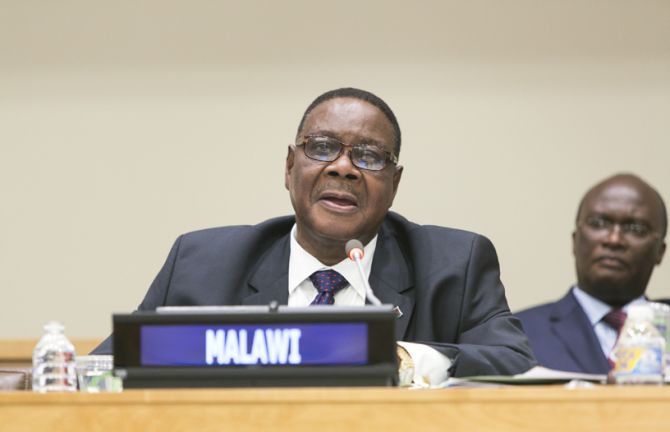
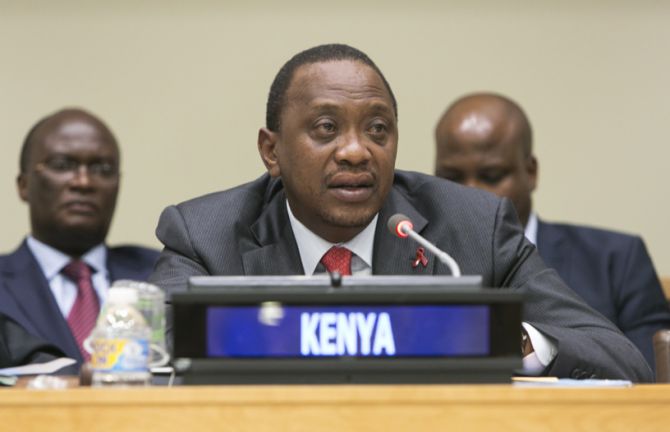

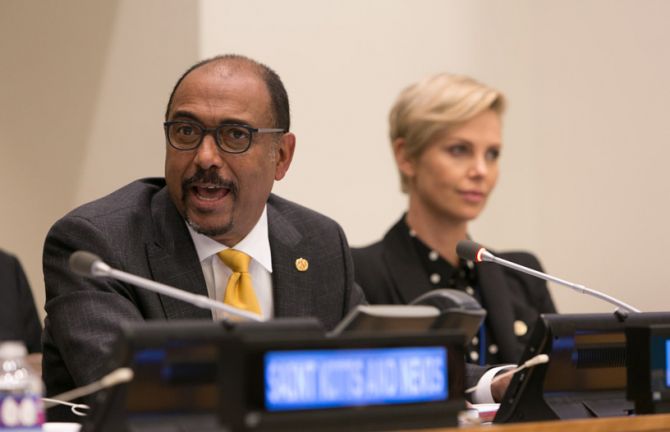
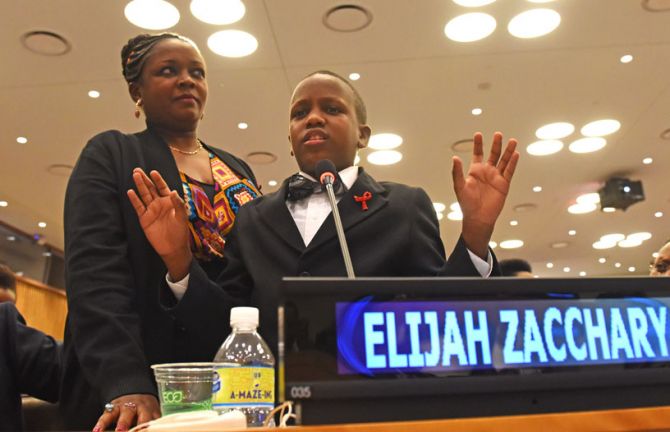
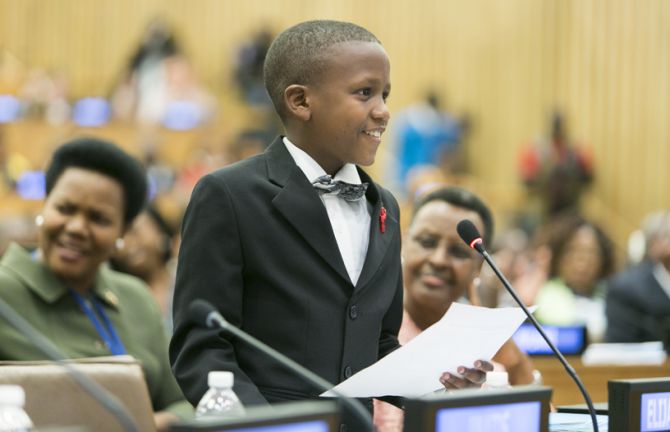
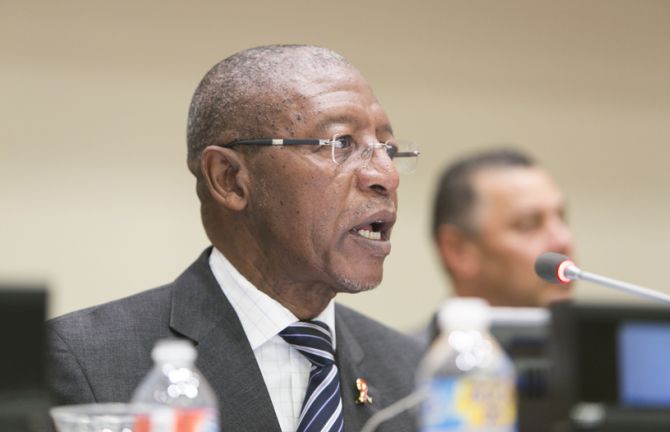
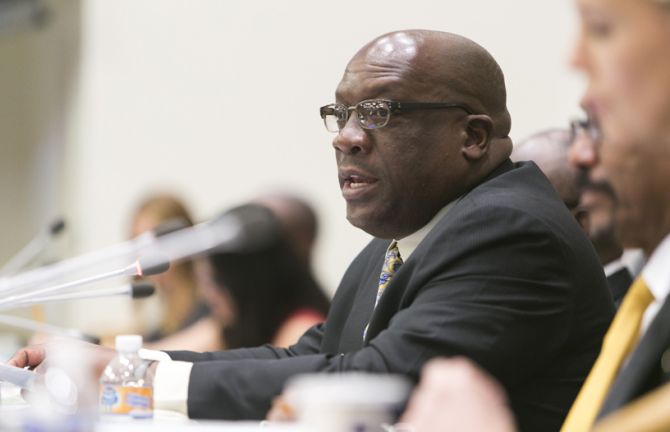
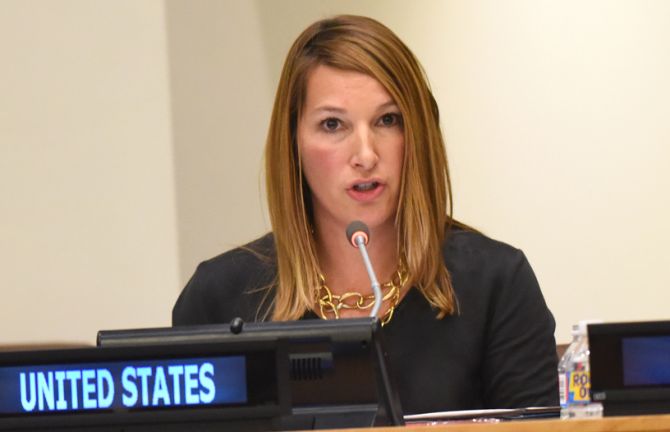
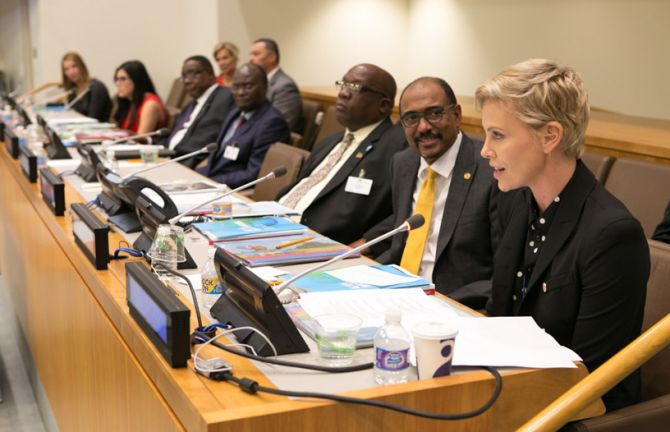
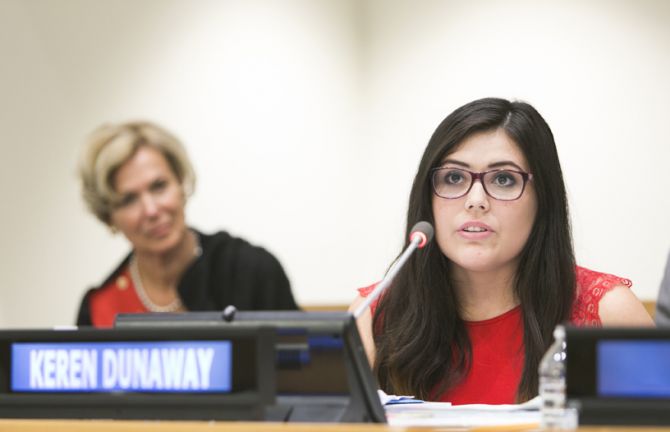
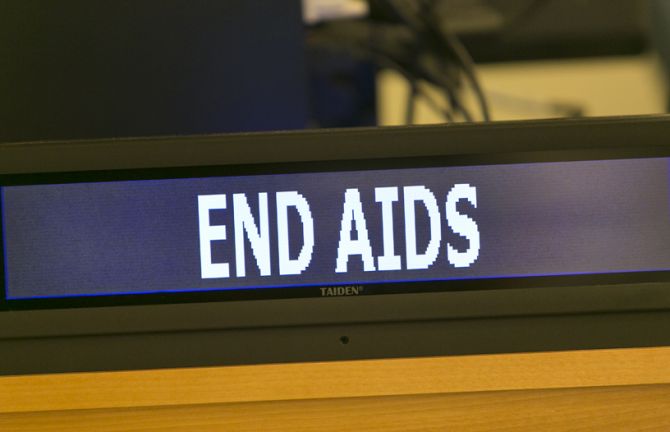
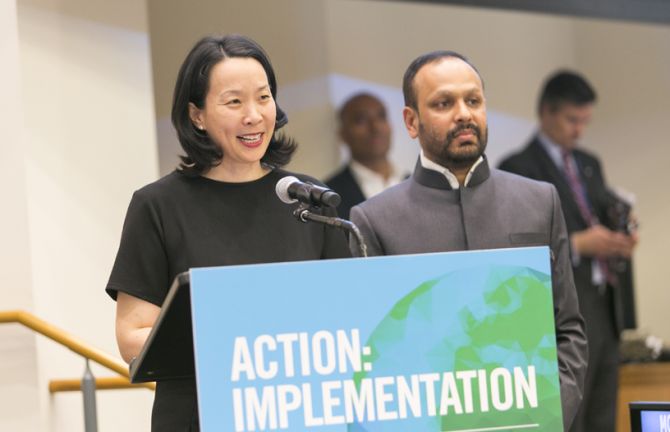

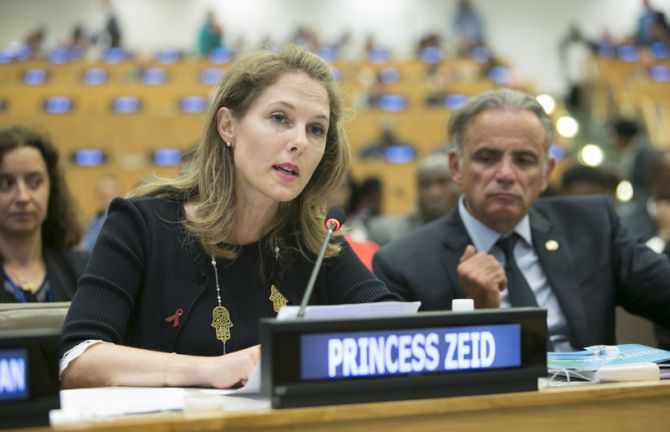
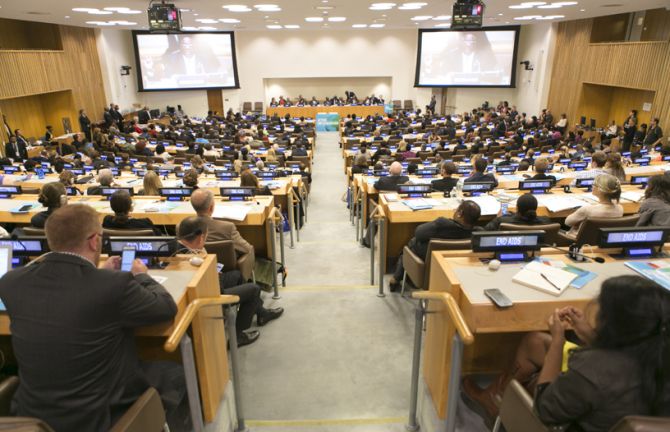
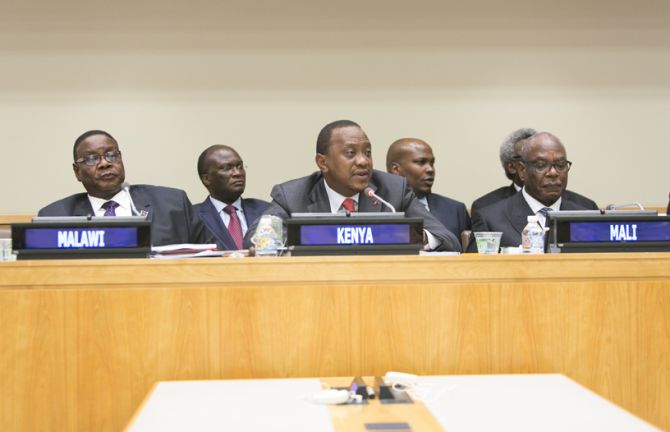
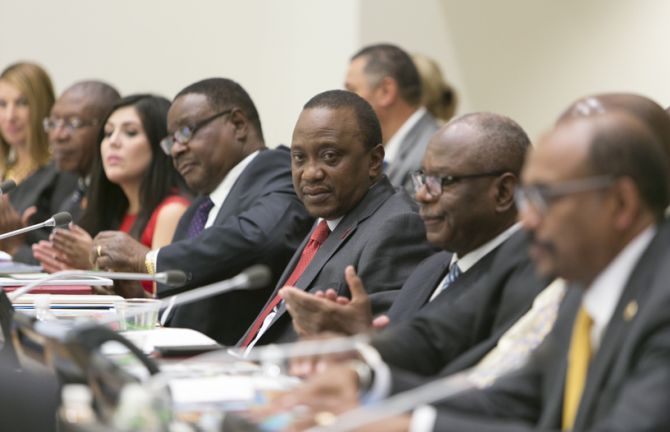
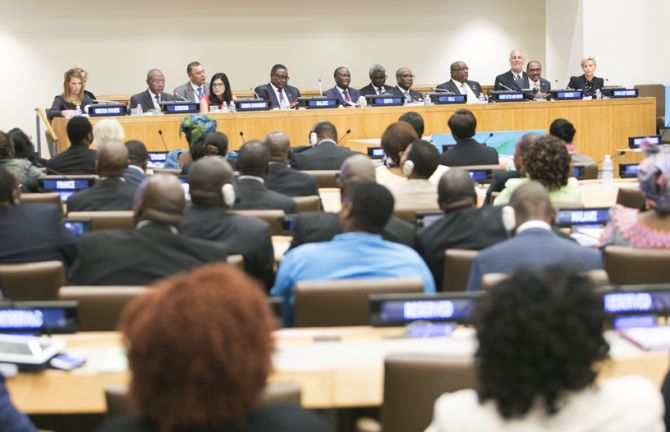
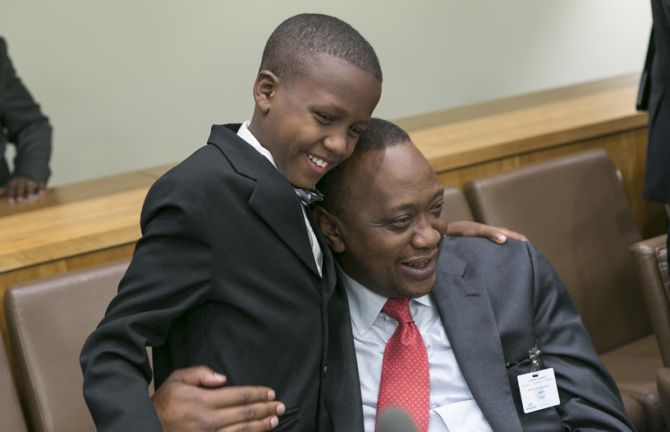
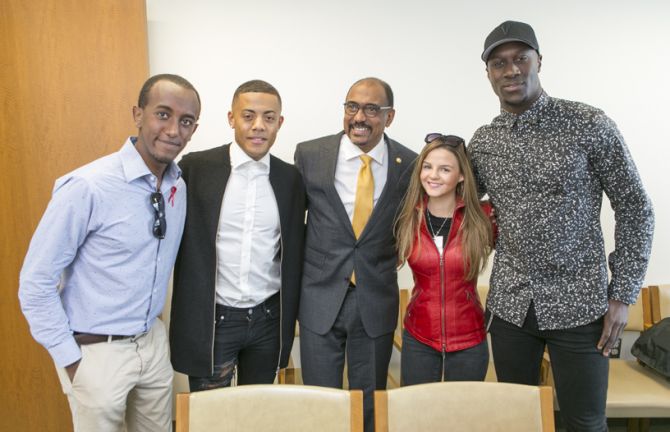
Press Release
World leaders call for accelerated action and smarter investments to Fast-Track the end of the AIDS epidemic
27 September 2015 27 September 2015Innovation and new means of implementation will ensure countries deliver on 2030 AIDS promises
NEW YORK/GENEVA, 27 September 2015—The Governments of Kenya and Malawi, together with UNAIDS, are leading an urgent call for new investment and improvements in health service delivery to put the world on course to ending the AIDS epidemic by 2030.
The call was made during a high-level event at the United Nations Headquarters in New York on the eve of the historic seventieth session of the United Nations General Assembly. Leaders from around the world gathered at the event to pledge their support and commitment to the UNAIDS Fast-Track approach and to finding new and innovative ways of delivering essential health care to people most in need.
“We believe we are on the right track, but reaching the Fast-Track Targets won’t be easy,” said President Peter Mutharika of Malawi. “We must expand and scale up HIV services. Malawi is ready to see this journey through and end AIDS by 2030.” Malawi has already taken bold steps to reach its targets, having recently announced that it will provide antiretroviral therapy to everyone living with HIV as of April 2016.
The AIDS response to date has been the most successful response to any modern epidemic. There have been massive reductions in new HIV infections and AIDS-related deaths over the past 15 years and more than 15 million people now have access to antiretroviral therapy.
To take the AIDS response forward, UNAIDS has developed a Fast-Track approach to reach a set of time-bound targets by 2020. The targets include 90% of all people living with HIV knowing their HIV status, 90% of people who know their status having access to treatment and 90% of people on treatment having supressed viral loads. They also include reducing new HIV infections by 75% and achieving zero discrimination.
“Over the last decades we have made great progress in combatting AIDS but it is still unfinished business,” said President Uhuru Kenyatta of Kenya. “We must all continue to galvanize additional resources for the AIDS response, both international and domestic. We must invest in HIV prevention, care and treatment services because there is simply no other option.”
The massive scale-up of services over the past 15 years has resulted in 30 million new HIV infections and 8 million deaths averted over the last 15 years.
“It is no longer a dream; we have to believe that we can end AIDS. Unfortunately many people still continue to be stigmatized and we just need to push from every front to make sure that no one is left behind,” said President Ibrahim Boubacar Keïta of Mali.
Putting people at the centre was one of the ways identified as essential to ending the AIDS epidemic. Where people at higher risk of HIV infection and people living with HIV are empowered to realize their human rights, uptake of HIV services has increased.
“I believe the AIDS epidemic can be ended within the next 15 years,” said Michel Sidibé, Executive Director of UNAIDS. “Now, more than ever, we need means of implementation that are smart, efficient, sustainable and, most importantly, people-centred.”
Without inclusion and equity, key populations and young people will continue to be left behind. The meeting heard from Elijah Zacchary, a 12-year-old Kenyan boy living with HIV, who spoke of his hopes for the future. “Presidents, thank you for making the promise to end AIDS by 2030, but we must make sure that all children have access to treatment,” said Elijah. “My dream is that by the time I am 27 years old there shall be no more stigma and I am still able to take my medication every day.”
The leaders called for greater engagement of communities and innovative, community-led approaches to the delivery of health services. Innovation in community delivery is breaking the logjam in the capacity of health services to deliver life-saving prevention and treatment services and needs to be adequately funded and supported.
“To end AIDS in Lesotho, we need to integrate HIV into primary health care, adequately resource our best foot soldiers—the village health workers—mobilize communities through innovative approaches advocated by our Majesty the King and better coordinate support from our partners,” said Pakalitha Mosisili, Prime Minister of Lesotho.
Big challenges remain to end the epidemic. Of the 36.9 million people living with HIV globally 17.1 million do not know they have the virus and need to be reached with HIV testing services, and around 22 million do not have access to HIV treatment, including 1.8 million children.
“We in the Caribbean believe that we can be the first region in the world to end AIDS. Going forward with this aspirational goal requires increased investment, which is part of the global solidarity that we are here for today,” said Timothy Harris, Prime Minister of Saint Kitts and Nevis.
At current levels, there is an annual gap of US$ 12 billion globally between the resources available and the resources needed to reach the UNAIDS 2020 Fast-Track Targets and end the AIDS epidemic by 2030.
Earlier in the day, President Barack Obama spoke at the Sustainable Development Summit and announced that the United States of America had set new targets to reach more people with life-saving HIV prevention and treatment services, with a particular focus on young women and adolescent girls.
Heather Higginbottom, Deputy Secretary of State for Management and Resources of the United States, said, “We stand together to celebrate that progress, to demonstrate our collective resolve, and to meet the challenge before us in the new global goals: to end the AIDS epidemic by 2030.”
Over the next five years the AIDS response requires front-loading investments and increasing the diversity of investment, innovative delivery mechanisms and partnerships to ensure that no one is left behind, especially adolescents, young people and key populations. Ensuring commodity security to sustain the AIDS response, focusing on locations, populations and programmes that deliver the greatest impact and addressing discrimination and gender inequality and committing to people-centred approaches grounded in human rights will reap huge benefits by 2030: 21 million AIDS-related deaths averted; 28 million new HIV infections averted; and 5.9 million new infections among children averted.
“There is a generation in jeopardy. Young people are falling through the cracks in the AIDS response," said Charlize Theron, Messenger of Peace for the United Nations and founder of the Charlize Theron Africa Outreach Project. “But there is reason to hope, we know what works—empowering young people to take care of their health.”
Karen Dunaway, a young woman from Honduras living with HIV, said, “We adolescents and young people should have the space to participate meaningfully in decision-making at all levels, including policy-making and implementation. Governments must work with civil society and young people to ensure accountability. Together we must break the prejudice and stigma so that all young people have access to services.”
Better health outcomes will support the entire Sustainable Development Goals framework and not only lead to healthier lives, but also help alleviate poverty, reduce discrimination and improve economic security.
UNAIDS
The Joint United Nations Programme on HIV/AIDS (UNAIDS) leads and inspires the world to achieve its shared vision of zero new HIV infections, zero discrimination and zero AIDS-related deaths. UNAIDS unites the efforts of 11 UN organizations—UNHCR, UNICEF, WFP, UNDP, UNFPA, UNODC, UN Women, ILO, UNESCO, WHO and the World Bank—and works closely with global and national partners towards ending the AIDS epidemic by 2030 as part of the Sustainable Development Goals. Learn more at unaids.org and connect with us on Facebook, Twitter, Instagram and YouTube.
Contact
UNAIDS New YorkSophie Barton-Knott
tel. +41 79 514 6896
bartonknotts@unaids.org
UNAIDS Geneva
Michael Hollingdale
tel. +41 79 500 2119
hollingdalem@unaids.org
Press centre
Download the printable version (PDF)

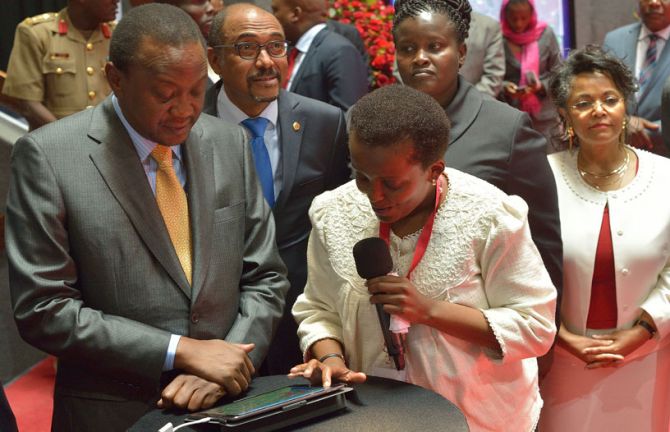
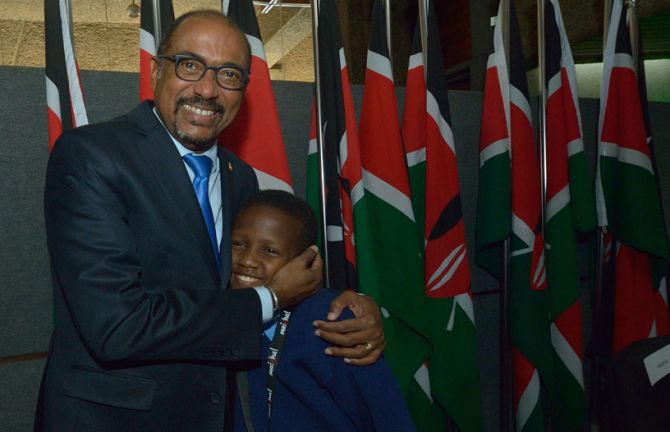
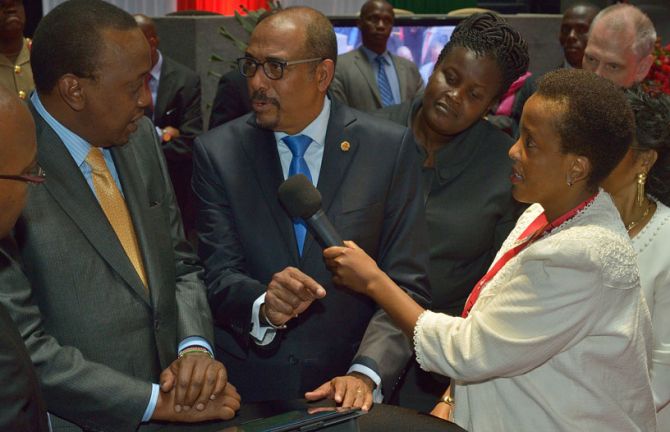
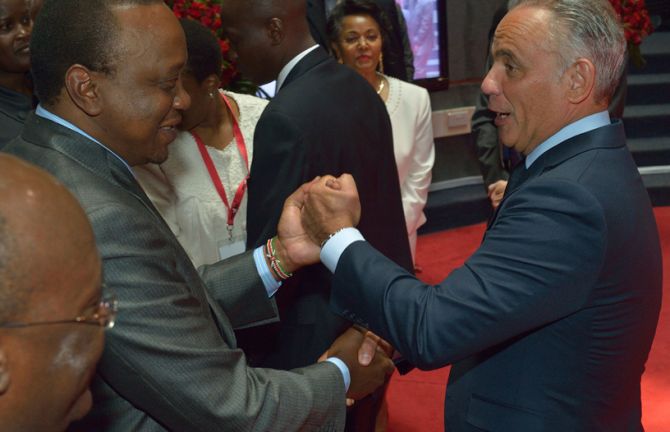
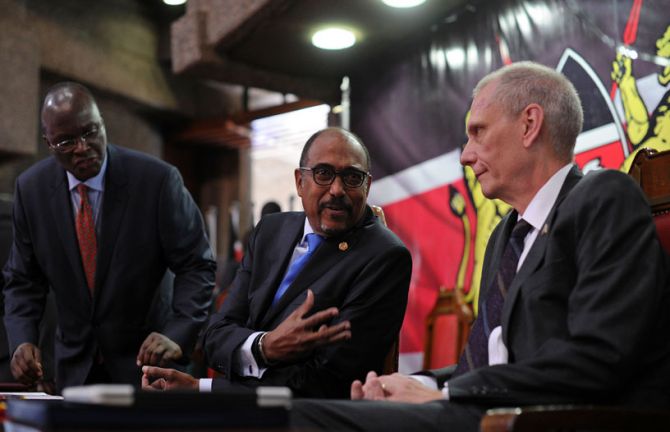
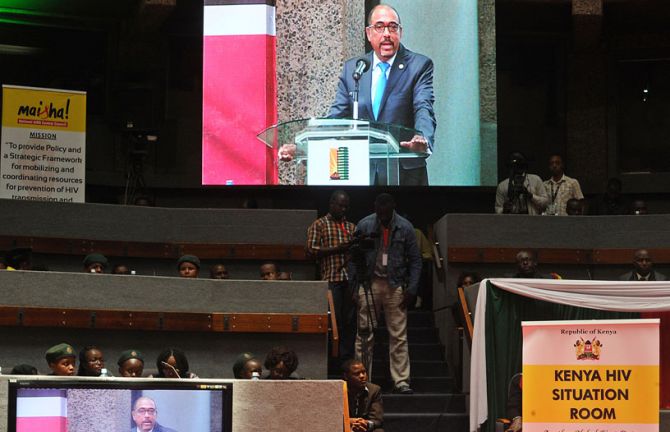
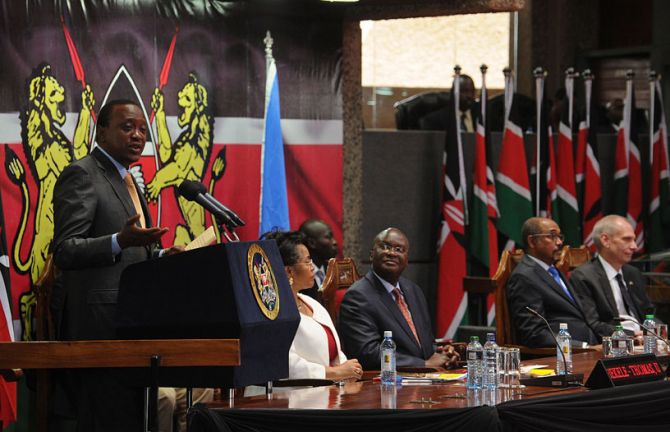
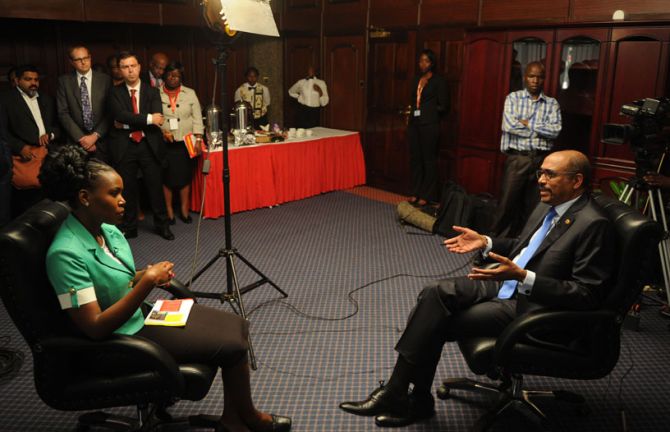
Press Release
UNAIDS and Kenya launch data and technology partnership to Fast-Track progress towards ending the AIDS epidemic by 2030
17 September 2015 17 September 2015Kenya HIV Situation Room centralizes HIV data to ensure more effective and precise programming and reach more people with life-saving services
NAIROBI/GENEVA, 17 September 2015—The President of Kenya, Uhuru Kenyatta, and the Executive Director of UNAIDS, Michel Sidibé, have launched an innovative new tool to track progress and identify gaps in HIV programming in Kenya.
The Kenya HIV Situation Room brings together logistics and service delivery data to produce a more comprehensive picture and understanding of Kenya’s epidemic. The Kenya HIV Situation Room will enable quick feedback on results at the county and community levels and identify any bottlenecks and access issues. Its aim is to speed up and streamline communications between policy-makers and implementers and to help Kenya stay on track to reach its national health targets and improve the lives of people living with and affected by HIV across the country.
“As we all know what gets measured gets done,” said President Kenyatta, “I am pleased that today the Internet based dashboard, the Kenya HIV Situation Room has been unveiled. The use of ICT is a priority for my government”.
Latest data from the Kenya HIV Situation Room shows that Kenya is close to having 800 000 people on treatment.
“High velocity data is critical for insights into a more effective and efficient response to HIV. President Kenyatta’s leadership will help Africa accelerate progress towards ending the AIDS epidemic as part of the sustainable development goals,” said Mr Sidibé. “It can serve in a similar manner to track progress against other diseases, such as tuberculosis and malaria.”
By adopting a people-centred approach to its response to ensure that no one is left behind, Kenya has been able to accelerate progress towards ending its AIDS epidemic. New HIV infections fell by 77% from 250 000 [220 000 - 290 000] from their peak in 1993 to 56 000 [47 000 - 67 000] in 2014.
AIDS-related deaths were reduced by 74% from 130 000 [100 000 - 170 000] at the peak in 2003 to 33 000 [25 000 - 45 000] in 2014 as access to antiretroviral treatment was scaled up. In 2014, around 57% [50%-66%] of adults living with HIV in Kenya had access to the lifesaving medicines and 67% [59%-78%] of pregnant women living with HIV had access to medicine to prevent transmission of the virus to their child. This has resulted in a 74% decline in new HIV infections among children since the peak in 1994.
The Kenya HIV Situation Room will enable AIDS programme staff to localize where efforts need to be intensified. This more accurate programming will help to ensure that mothers have access to HIV testing early on in their pregnancy, that children living with HIV have regular access to care and treatment and that antiretroviral medicines are replenished quickly should stock-outs occur. All information is measured by each facility and service delivery point and fed back to the Kenya HIV Situation Room. The information is anonymous to ensure that full confidentiality is maintained.
The Government of Kenya and UNAIDS have worked together to bring four different data sets into one tool: data from the District Health Information System; information from the Kenya Medical Supply Agency; Kenya’s HIV estimates; and data from the National AIDS Control Council on programme implementers and service delivery.
The Kenya HIV Situation Room, developed by the National AIDS Control Council and the Kenyan Ministry of Health in collaboration with UNAIDS, is supported by the Government of Japan, which contributed resources as part of its continued support to improving monitoring and evaluation of the global AIDS epidemic.
During the event in Nairobi, President Kenyatta also reported progress made in reaching adolescents with HIV services and announced that Kenya would be launching a new Presidential campaign against stigma and discrimination.
“Our constitution guarantees every child a right to education, the highest available standard of health and protection from all forms of discrimination.” said President Kenyatta, “We cannot change anyone’s HIV status but we can change our attitude. Let us stop stigma and let us stop it right now.”
The campaign is designed to encourage young people to know their HIV status as part of the Kenya Fast-Track plan to reduce new HIV infections and increase access to treatment among adolescents and young people.
UNAIDS
The Joint United Nations Programme on HIV/AIDS (UNAIDS) leads and inspires the world to achieve its shared vision of zero new HIV infections, zero discrimination and zero AIDS-related deaths. UNAIDS unites the efforts of 11 UN organizations—UNHCR, UNICEF, WFP, UNDP, UNFPA, UNODC, UN Women, ILO, UNESCO, WHO and the World Bank—and works closely with global and national partners towards ending the AIDS epidemic by 2030 as part of the Sustainable Development Goals. Learn more at unaids.org and connect with us on Facebook, Twitter, Instagram and YouTube.
